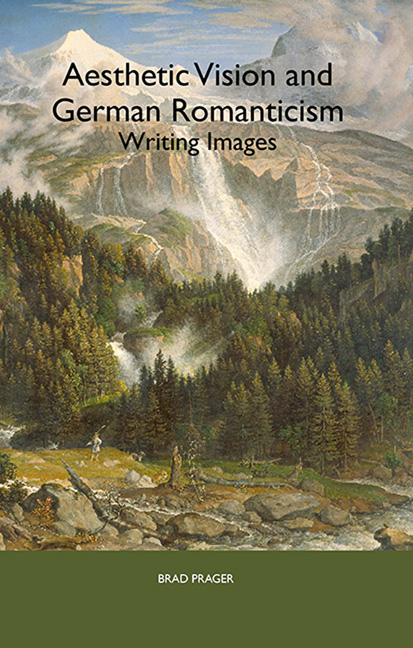Book contents
- Frontmatter
- Contents
- List of Illustrations
- Acknowledgments
- Introduction
- 1 Interior and Exterior: G. E. Lessing's Laocoon as a Prelude to Romanticism
- 2 Image and Phantasm: Wackenroder's Herzensergießungen eines kunstliebenden Klosterbruders, Tieck's Franz Sternbalds Wanderungen, and the Emergence of the Romantic Paradigm
- 3 Symbol and Allegory: Clemens Brentano's Godwi
- 4 Sublimity and Beauty: Caspar David Friedrich and Joseph Anton Koch
- 5 Light and Dark: The Paintings of Philipp Otto Runge
- 6 Absolution and Contradiction: Confrontations with Art in Heinrich von Kleist's “Die heilige Cäcilie oder Die Gewalt der Musik” and “Der Findling”
- 7 Self and Other: Joseph von Eichendorff's Das Marmorbild
- Conclusion
- Notes
- Works Cited
- Index
2 - Image and Phantasm: Wackenroder's Herzensergießungen eines kunstliebenden Klosterbruders, Tieck's Franz Sternbalds Wanderungen, and the Emergence of the Romantic Paradigm
Published online by Cambridge University Press: 13 April 2017
- Frontmatter
- Contents
- List of Illustrations
- Acknowledgments
- Introduction
- 1 Interior and Exterior: G. E. Lessing's Laocoon as a Prelude to Romanticism
- 2 Image and Phantasm: Wackenroder's Herzensergießungen eines kunstliebenden Klosterbruders, Tieck's Franz Sternbalds Wanderungen, and the Emergence of the Romantic Paradigm
- 3 Symbol and Allegory: Clemens Brentano's Godwi
- 4 Sublimity and Beauty: Caspar David Friedrich and Joseph Anton Koch
- 5 Light and Dark: The Paintings of Philipp Otto Runge
- 6 Absolution and Contradiction: Confrontations with Art in Heinrich von Kleist's “Die heilige Cäcilie oder Die Gewalt der Musik” and “Der Findling”
- 7 Self and Other: Joseph von Eichendorff's Das Marmorbild
- Conclusion
- Notes
- Works Cited
- Index
Summary
For the Romantics the canvas and the written page were sites of contestation, spaces on which ephemeral experience was said to be represented in the material world. Art, understood in these terms, became the middle point or stage upon which something absent and intangible was made to appear present and graspable. It was, in other words, a material invocation of a sphere unavailable to the senses. In the following chapter I attempt to reconstruct the model of aesthetic perception in the work of Wackenroder and Tieck in light of the epistemological and perceptual categories laid out by Lessing's essay on the subject of the Laocoon. Their works appeared early in the history of German Romantic thought and thus bridged the gap between understandings of visual perception dating from shortly before and after 1800, taking their cues from classical thought — as had much of the work of their contemporaries. Once one takes note of the influences, Wackenroder's Herzensergießungen eines kunstliebenden Klosterbruders (Outpourings of an Art-Loving Friar, 1796–97), can be understood to stage and revise the same conflict thematized in Lessing's work — between the external, material world and that of the imagination — in terms of its author's dual fascination with Christian faith and classical philosophy. Suffusing his aesthetics with Christianity, Wackenroder contradicts and reorders the claims of the Laocoon, providing an origin for Romantic aesthetics at the outset of the eighteenth century. In the latter half of the chapter I argue that Tieck's understanding of aesthetic experience, as presented in his novel Franz Sternbalds Wanderungen (Franz Sternbald's Travels, 1798), reflected the situation of the artist even more closely as the latter tried to grab hold of the effervescent phantasm or to capture ungraspable forms on canvas. Embracing the paradoxical and often irresolvable nature of this quest, Tieck parted ways with neoclassicism and moved toward the articulation of a fully developed Romantic “phantasmology.” Considered together, the work of these two Romantics marks an important initial step away from the prose and visual art of the eighteenth century and toward the more modern problematics consistent with the turn-of-the-century focus upon the self.
In his Outpourings Wackenroder — assisted by numerous contributions from his close friend Tieck — undertakes to write a foundational text about the appreciation of painting and music.
- Type
- Chapter
- Information
- Aesthetic Vision and German RomanticismWriting Images, pp. 34 - 65Publisher: Boydell & BrewerPrint publication year: 2007



